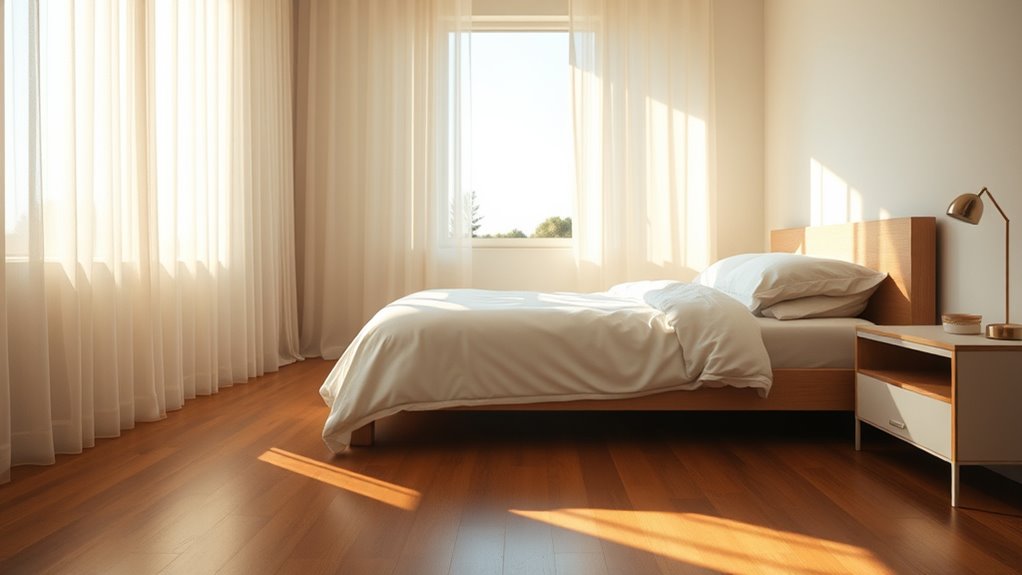To boost your circadian health, start your day with 15-30 minutes of outdoor sunlight exposure. This helps reset your internal clock, improves sleep, and lifts your mood by regulating hormones like melatonin and serotonin. Make it a daily habit by combining sunlight with mindfulness or movement. Limit artificial light at night for maximum results. If you stick to these tips, you’ll open long-term benefits for mood, sleep, and overall well-being.
Key Takeaways
- Spend 15-30 minutes outdoors in natural morning sunlight to reset your circadian clock effectively.
- Combine outdoor exposure with mindfulness or meditation to enhance mood and reinforce light therapy benefits.
- Prioritize outdoor activities in the morning and limit artificial light in the evening to support melatonin production.
- Use light therapy lamps during darker months to simulate natural light and maintain circadian alignment.
- Consistently incorporate morning sunlight routines to improve sleep quality, mood, and overall circadian health.
Understanding the Science Behind Circadian Rhythms

Understanding circadian rhythms is vital because they regulate your body’s natural 24-hour cycle, influencing sleep, alertness, and overall health. These rhythms depend on precise melatonin regulation, which signals your body when it’s time to sleep and wake. Exposure to light plays a key role in hormonal synchronization, helping your body align internal processes with the external environment. When your circadian clock functions properly, it guarantees that hormones like melatonin and cortisol work in harmony, promoting restorative sleep and peak energy levels. Disruptions to this system, such as irregular sleep schedules or insufficient daylight, can throw off hormonal synchronization, leading to fatigue and health issues. Recognizing how your body naturally responds to light helps you support healthy circadian rhythms and maintain balance. Additionally, understanding the role of light exposure in regulating these rhythms can help you adopt habits that reinforce your body’s natural cycle.
The Benefits of Morning Sunlight Exposure

Morning sunlight offers numerous health benefits by helping reset your circadian clock, ensuring your body remains in sync with the natural day-night cycle. Exposure to morning light boosts vitamin D production, which supports your immune system, mood, and bone health. It also helps regulate your sleep-wake patterns, leading to better rest and increased alertness during the day. Additionally, morning sunlight can reduce symptoms of Seasonal Affective Disorder by improving serotonin levels and lifting your mood. Regular exposure to natural light in the morning strengthens your circadian rhythm, making it easier to fall asleep at night and wake feeling refreshed. Incorporating top mattress toppers can further enhance your sleep quality, making morning sunlight exposure even more beneficial. Embracing this daily habit can markedly enhance your overall well-being, mood, and energy levels.
How to Incorporate Sunlight Into Your Morning Routine

To effectively incorporate sunlight into your morning routine, start by planning to spend at least 15-30 minutes outside shortly after waking up. This allows you to harness the benefits of sunlight therapy, which helps regulate your circadian rhythm and boost mood. During this time, consider practicing your morning meditation outdoors, combining mindfulness with natural light exposure. Find a comfortable spot where you can relax and breathe deeply while soaking up the sunlight. If direct sunlight is limited, sit near a window that lets in plenty of morning light. Incorporating light exposure benefits into your routine can further enhance your overall well-being. Consistency is key—making this a daily habit helps reinforce your body’s internal clock. By intentionally integrating sunlight and mindfulness into your morning, you’ll set a positive tone for the rest of your day.
Best Practices for Optimizing Light Exposure

Maximizing the benefits of light exposure requires intentional strategies to guarantee your body receives adequate natural light throughout the day. To do this, prioritize morning sunlight and spend time outdoors when possible. Use light therapy techniques, such as light boxes, to simulate natural light, especially during darker months. Phototherapy benefits include improved mood and circadian rhythm regulation. Create a routine that aligns with your natural sleep-wake cycle. Visualize this:
| Time of Day | Recommended Action | Light Source |
|---|---|---|
| Morning | Sunlight exposure | Natural or light therapy device |
| Afternoon | Breaks outside | Natural sunlight |
| Evening | Limit artificial light | Dim, warm lighting |
Engaging in morning sunlight can also help reset your internal clock, promoting better sleep quality.
Overcoming Challenges and Limitations

While prioritizing morning sunlight and outdoor breaks can markedly boost your circadian health, various challenges may hinder consistent exposure. Weather conditions, especially during winter, can limit your outdoor time, making natural light harder to access. In such cases, light therapy lamps serve as a reliable alternative, helping to counteract seasonal affective disorder and maintain your circadian rhythm. Indoor work environments and busy schedules also reduce your chances for natural exposure, but establishing a routine—like morning walks or outdoor coffee breaks—can help. If outdoor options are limited, using light therapy consistently can bridge the gap. Recognizing these obstacles allows you to adapt strategies and stay committed to optimizing your light exposure, ensuring your circadian health remains resilient despite seasonal or environmental challenges. Incorporating light therapy products into your routine, especially during darker months, can provide the necessary stimulation to support your circadian rhythm.
Long-Term Effects on Sleep, Mood, and Health

Consistently getting morning sunlight and outdoor exposure can lead to significant long-term benefits for your sleep quality, mood stability, and overall health. Regular sunlight helps regulate your circadian rhythm, reducing the risk of seasonal affective disorder and improving mood during darker months. Over time, this practice can lessen the severity of jet lag by resetting your internal clock after travel, making progressions smoother. Enhanced circadian alignment supports better sleep patterns, increased energy, and a more stable mood. It also boosts immune function and reduces the risk of chronic conditions like cardiovascular disease. By making morning sunlight a daily habit, you invest in your long-term well-being, creating a resilient foundation against seasonal affective challenges and travel-related disruptions. Proper circadian regulation is essential for maintaining optimal health and resilience over time.
Frequently Asked Questions
Can Artificial Light Mimic the Effects of Natural Sunlight on Circadian Rhythms?
Artificial light can mimic natural sunlight to some extent through light therapy, but it’s not as effective for circadian entrainment. You need bright, blue-enriched light during the morning to help reset your internal clock properly. While artificial light can support your circadian rhythms, it often lacks the full spectrum and intensity of natural sunlight, making it less ideal for ideal circadian health.
How Does Age Affect the Efficiency of Morning Sunlight Exposure?
Age affects your body’s ability to absorb sunlight, impacting your circadian clock’s clarity. As you age, age-related circadian changes occur, diminishing sunlight absorption efficiency and reducing morning light’s energizing effects. You might find it harder to wake up naturally or maintain consistent sleep patterns. To counteract this, prioritize early sunlight exposure, adjust your routines, and consider supplemental light sources to support your circadian health as you grow older.
Are There Specific Times of Year When Sunlight Exposure Is More Beneficial?
You might notice seasonal sunlight varies in its benefits throughout the year. During winter daylight, sunlight is often weaker and less consistent, making morning exposure especially important to help regulate your circadian rhythms. In contrast, summer sunlight offers longer, stronger days, so you can get your light boost later in the day. Prioritizing morning sunlight during winter helps maintain your sleep-wake cycle and overall health.
What Are the Risks of Excessive Morning Light Exposure?
Ah, the joys of chasing that perfect sunrise—until your skin sensitivity turns into sunburn drama. Excessive morning light exposure can lead to skin sensitivity, increasing the risk of burns and long-term damage. Plus, too much vitamin D overload might seem like a health win, but it can cause nausea or kidney issues. So, enjoy the morning glow, but don’t turn yourself into a lobster or a vitamin D overdose statistic.
How Can Urban Environments Optimize Sunlight Exposure for Residents?
To optimize sunlight exposure in urban environments, you should consider reducing urban shading by designing open spaces that allow sunlight to reach residents. Incorporate rooftop gardens, which not only provide natural light but also create green zones that promote outdoor activity and sunlight exposure. By balancing shaded areas with open, sunlit spaces, you can help residents benefit from natural light while minimizing risks of overexposure, supporting overall health.
Conclusion
Don’t let cloudy mornings or busy schedules stop you from reaping the benefits of morning sunlight. Even a few minutes outside can boost your mood, improve sleep, and support overall health. If the weather isn’t ideal, try sitting near a window or using a light therapy box. Consistency is key—your body will thank you for prioritizing this simple, effective step in maintaining your circadian rhythm and long-term well-being.









